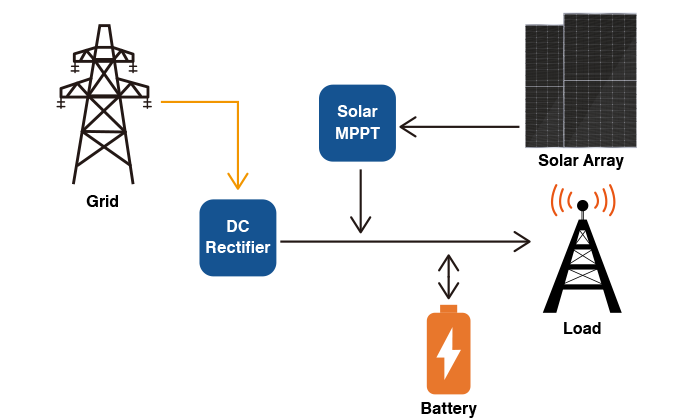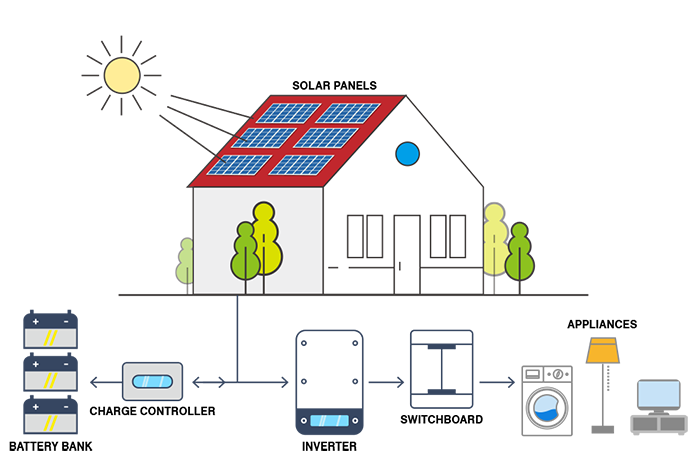The PV system is split into five modes:
1. Self-use, residual power on the grid
2. Self-use, residual power off the grid
3. Full grid
4. Off-grid and On/off-grid
5. Self-use, surplus energy to the gird
Self-use, residual power on the grid
This photovoltaic system model is the most common one, the general distributed photovoltaic power system largely used in this model.
The electricity produced by the photovoltaic system can be used first to meet its own load, and the excess can be sold to the grid company to avoid wasting it; if the photovoltaic power generated is insufficient, the grid will supply it. However, this mode of access needs to negotiate with the grid company good appropriate power sales agreements, taking into account the interests of both sides. Two-way smart meters are placed by grid companies to measure the generation capacity of photovoltaic plants and the energy consumption of consumers, and to pay or collect electricity charges according to policies and negotiated tariffs.
The biggest drawback of this model is that its revenue model can not be fixed, the ratio of self-use and residual power to the grid is always changing, and the estimated value of the plant when it is financed and sold may be somewhat lower than the actual output, even the management can not obtain a reasonable asset value because they are worried about the future operation of the users.
Self-use, residual power off the grid
The remarkable feature of the self-use grid-connected approach is “Grid-connected without internet”. The access point of this type is at the lower end of the grid company meter and is the private side of the full property demarcation point. In theory, the grid company won't interfere with the system's access, but this model needs that photovoltaic power can not be sent to the grid, so there must be a counter-current device. When the power generated by a photovoltaic plant exceeds its load, the counter-current protection device must feed the signal back to the inverter, which will reduce the capacity according to the load, so as to meet the load demand and not transmit electricity to the grid, so as to achieve the function of the photovoltaic system to prevent the counter-current.
This photovoltaic system model is generally applied in the case of a large user-side power consumption load, continuous power consumption, little or no shutdown or semi-shutdown during the year, or even during holidays, the user's power maintenance load is also large enough to absorb the vast majority of the electricity generated by the PV system. As far as possible, the power produced by the PV system will be used up without causing waste.
Full grid
In this grid-connected mode, the AC output of the PV system is directly connected to the low-voltage side or high-voltage side of the grid, that is, the grid side of the property border. In this way, the electricity produced by the system is sold directly to the grid company, and the selling price is usually the local average feed-in price, while the user's electricity price stays unchanged, this is called“Two lines of income and expenditure, each accounting for its own account''.
Direct grid-to-grid sales are also the mainstream of PV applications; investors like the model because it is easy and relatively reliable.

Off-grid and On/off-grid
This off-grid model, also known as stand-alone photovoltaic (PV) power stations, is a system that operates independently of the grid and is widely used because it is not geographically restricted, as long as there is sunlight can be installed and used, it is very suitable for remote areas without power grid, isolated islands, fishing boats, outdoor breeding bases, etc. . It can also be used as emergency power generation equipment in places with frequent power outages.

But this kind of power generation system must be equipped with batteries, and hold a relatively high cost of power generation system. And the battery life, the need to maintain replacement, raised the cost of use. So the economy, it is tough to be widely used, so do not recommend the use of electricity convenient place.
It is also very practical for households in areas where there is no electricity grid or where there is frequent power cuts. In particular, it is used solely to solve lighting problems during blackouts. Therefore, off-grid power generation systems are specifically designed for use in off-grid areas or in areas with frequent power outages.
Photovoltaic street lamps, lawn lamps and other photovoltaic products, is also a photovoltaic off-grid system.
Self-use, surplus energy to the gird
The application scenarios of this combined/off-grid mode are frequent power outages, or the self-use price is much more expensive than the on-grid price, and the peak price is much more expensive than the trough price.
This is the use of photovoltaic power to load, can be set at the peak price output, reduce the cost of electricity; second, can be charged at the valley, peak discharge, making use of the price difference between peak and valley to make money; third, when the grid is normal power supply, the system operates as a normal grid-connected system, where photovoltaic power is fed to the load first, and excess power is stored in batteries or sold to the grid, the inverter can be switched to off-grid mode, the system continues to work as a backup power supply, photovoltaic and battery power to important load through the inverter, no waste.
On/off-grid mode and off-grid mode are the same needs of batteries, the initial cost of investment is relatively large.
This mode of access needs to negotiate with the power grid company the relevant power sales agreement, taking into account the interests of both sides.
In general, most will use the grid-connected mode; which one to choose, according to the specific requirements of the project.







